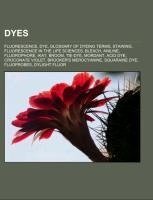
Dyes
Source: Wikipedia. Pages: 48. Chapters: Fluorescence, Dye, Glossary of dyeing terms, Staining, Fluorescence in the life sciences, Bleach, Aniline, Fluorophore, Ikat, Broom, Tie-dye, Mordant, Acid dye, Croconate violet, Brooker's merocyanine, Squaraine dye,... Viac o knihe
Produkt je dočasne nedostupný
15.58 €
bežná cena: 17.70 €
O knihe
Source: Wikipedia. Pages: 48. Chapters: Fluorescence, Dye, Glossary of dyeing terms, Staining, Fluorescence in the life sciences, Bleach, Aniline, Fluorophore, Ikat, Broom, Tie-dye, Mordant, Acid dye, Croconate violet, Brooker's merocyanine, Squaraine dye, FluoProbes, DyLight Fluor, Dye tracing, Viologen, Murexide, 4-Nitroaniline, BODIPY, Croconate blue, Vat dye, Reactive dye, Indocyanine green, 2-Nitrodiphenylamine, Sulfur dye, List of dyes, Bluing, Formazan, Leuco dye, Induline, Naphthol Green B, Dichlorofluorescein, Marking blue, Dylon, ANNINE-6plus, Puccoon, Nigrosin, Rylene dye, Carbene dye, Abir, Glycoazodyes, Solvent dye, Martius yellow, Pittacal, NBD-TMA, Naphthol yellow S, Mrs. Stewart's Bluing, Vinyl dye, CLD chromophore, Azadipyrromethene, Procion, Substantive dye, Thermochromatic ink, Reactive dye printing, Ring dyeing, Seminaphtharhodafluor, Cresidinesulfonic acid, Nigrosene, Bimane. Excerpt: Dyeing is the craft of imparting colors to textiles in loose fiber, yarn, cloth or garment form by treatment with a dye. Archaeologists have found evidence of textile dyeing with natural dyes dating back to the Neolithic period. In China, dyeing with plants, barks and insects has been traced back more than 5,000 years. Natural insect dyes such as Tyrian purple and kermes and plant-based dyes such as woad, indigo and madder were important elements of the economies of Asia and Europe until the discovery of man-made synthetic dyes in the mid-19th century. Synthetic dyes quickly superseded natural dyes for the large-scale commercial textile production enabled by the industrial revolution, but natural dyes remained in use by traditional cultures around the world. aalAal or Indian mulberry (Morinda tinctoria) is the source of the morindone dye sold under the trade name "Suranji". It is extensively cultivated in India for the dyeing of cotton, silk and wool in shades of red, chocolate or purple, dependent on the mordant used.adjectiveAdjective dyes are those dyes that require use of a mordant to bind the color to the fiber.alkanetAlkanet or dyer's bugloss (Alkanna tinctoria) is a traditional plant source of red dye.alumAlum (aluminum sulfate) is a naturally-occurring basic mordant widely used in the ancient world.añilAñil (Indigofera suffruticosa) is an indigo dye-bearing plant of Central and South America.anilineAniline or basic dyes are a class of synthetic dyes derived from coal tar, first discovered in the 19th century. These dyes produce brilliant colors that work well with animal fibers, especially silk. Because of poor colorfastness, aniline dyes are seldom used with textiles today.archilArchil is a dye produced from the lichen Roccella tinctoria which also produces cudbear and litmus. bloodrootBloodroot (Sanguinaria canadensis) or puccoon is a perennial, herbaceous flowering plant native to eastern North America that is the source for a red dye used by Native Ameri
- Vydavateľstvo: Books LLC, Reference Series
- Formát: Paperback
- Jazyk:
- ISBN: 9781157595014


 Anglický jazyk
Anglický jazyk 
 Nemecký jazyk
Nemecký jazyk 







